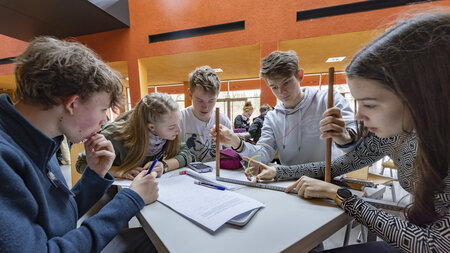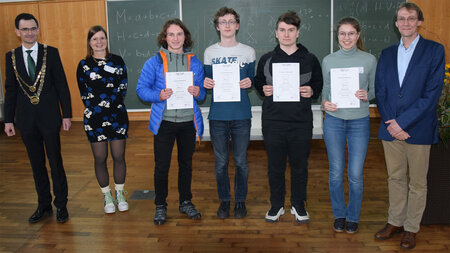Numerical solution of a bending-torsion model for elastic rods [ arXiv ]
by Sören Bartels and Philipp Reiter
| Abstract | Aiming at simulating elastic rods, we discretize a rod model based on a general theory of hyperelasticity for inextensible and unshearable rods. After reviewing this model and discussing topological effects of periodic rods, we prove convergence of the discretized functionals and stability of the corresponding discrete flow. Our experiments numerically confirm thresholds e.g. for Michell's instability and indicate a complex energy landscape, in particular in the presence of impermeability. |
|---|
On this page we present some animations from our paper. The total energy is a linear combination (with positive coefficients) of the bending energy, the twisting energy, a penalizing term (preventing degenerations of the frame), and, in order to model impermeability, the tangent-point potential. The total twist denotes 1/(2π) times the cumulative angle that the so-called directors (normal to the tangent of the centerline) of the framing encloses with a twist-free framing. For further details we refer to our preprint. Please note that we added some noise if our initial curves are stationary points of the total energy. Furthermore, we perform a rotation at the end of the simulation in order to visualize the geometry.
Spreading twist
The twist rate of any equilibrium rod is uniform. So we expect spreading of twist along the evolution. Here we start with an open curve, a straight line (zero bending energy), with non-uniform twist rate.
The evolution of permeable elastic rods
The first evolution starts with a round circle framed by five full rotations. If the parameters of the total energy are chosen accordingly (→ Michell's instability), this is not a stable configuration. By performing two self-penetrations, the rod reduces its twisting energy by (temporarily) increasing its bending energy. The final configuration is again a round circle (the unique minimizer of the bending energy) framed with only one full rotation. Here, following each self-intersection, the total twist is reduced by two full rotations. Reducing the total twist to zero is not possible (as long as the centerline is a round circle) on topological grounds.
In the next simulation, we start with an elastic figure eight. Its centerline lies in a plane which is parallel to the screen. Apart from the round circle it is the only closed planar elastica, i.e., a stationary point of the bending energy. Our initial rod is twist-free (zero twisting energy), however, again due to the choice of parameters (→ Ivey & Singer), it is unstable. We see the evolution of the figure eight to a round circle which is perpendicular to the screen. The bending energy decreases at the expense of increasing both total twist and twisting energy.
Our scheme also works for (clamped) open rods. The centerline of the initial rod is a planar sine curve and the frame performs more than six full rotations. As in the case of closed curves we observe that twist is reduced by self-penetrations.
Incorporating impermeability
We repeat two of the above experiments in the presence of impermeability. As twist can no longer be reduced by self-penetrations, we face equilibria that are determined by a seemingly complicated trade-off between bending and twisting energy. Here we observe the formation of so-called plectonemes.
Essentially the same phenomonon takes place in the case of a clamped open rod.




